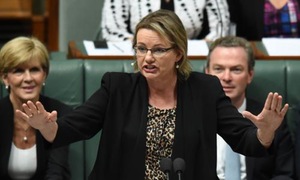
Like all commonwealth department offices, the department of health building in Canberra has all the photos of the relevant ministers going back to Federation.
Sussan Ley, the current health minister, will find among those photos that of Sir Earle Christmas Page, health minister in the Menzies government from 1949 to 1956. Like Ley, Page represented a NSW country seat and like Page, she has been given a report that paints a “disturbing picture” of mental health across Australia.
Robert Menzies had agreed in 1954 to appoint Melbourne psychiatrist Allan Stoller to examine the state of mental health care following continuing public debate and widespread reports of problems. Stoller’s report painted a damning picture of “Dickensian-like conditions” and left Menzies and Page with a major dilemma – to intervene in what to that point had been entirely a matter for the states or stand by and hope for change.
Menzies acted. He took direct action through announcing that the commonwealth would establish a capital rebuilding program. A £10m allocation from the commonwealth would be available on a 1:2 basis to the states for rebuilding psychiatric hospitals.
Last year, the government commissioned the National Mental Health Commission to look into the nation’s mental health system. The 2014 Review of Mental Health Programmes and Services report – which was handed to the government five months ago, but was only released last week after being leaked to the ABC – is structured in such a way as to enable the government to take immediate and direct action.
It’s a report about the federal government’s spending and its own programs.
While the report acknowledges there can be some improved efficiencies by eliminating duplication and red tape, the greatest improvements will come from rebalancing the system with greater investment in prevention and early intervention.
This is not new – indeed the Second National Mental Health Plan from 1998, states much the same as does the report Out of Hospital, Out of Mind from the Mental Health Council of Australia in 2003.
Much has been made of the reported shift in funding from hospital beds to community services in the media with the minister rejecting the proposal before the report hit the streets.
The specifics of this proposal were to shift over time commonwealth indexation beginning with $100m in 2017-18 and growing to $300m in 2021-22. This would not result in any hospital bed closures as some of the hysteria claimed. It seems that it was a sort of backdoor proposal engineered to actually grow the overall share of health budget going into mental health services. Hopefully the government will reconsider that once the children have gone to bed.
Ley has indicated she would establish a committee to examine the report before responding. The time for reports and examinations is over. This report includes 12 “shovel ready” actions for the federal government to take in order to make immediate improvements. They include:
- At the top – establish mental health and social and emotional wellbeing teams in Indigenous primary care organisations linked to Indigenous specialist mental health services.
- Link ongoing commonwealth funding to community organisations and private providers to the use of single care plans to drive efficiencies and better connected care.
- Initiate regional mental health service mapping through the new primary health networks (PHNs) to identify existing services, community needs and gaps.
- Consolidate the headspace and National Centre for Youth Mental Health into one entity and redirect the savings from bureaucracy to frontline services. This will cut waste and improve access to services for young people where long waiting times often exist.
- Introduce five-year contracts to cut red tape for community organisations linked to outcome performance measures with pay-for-performance incentives.
- Bundle commonwealth programs for regional delivery through the PHNs to enable more equitable access to mental health care.
- Strengthen the central role of GPs through the use of evidence-based guidelines, practice incentive payments bundling and changes to the Medicare Benefits Schedule.
- Initiate reforms to the Better Access program including restoration of the extra sessions of psychological treatment where clinically necessary and initiatives to improve access outside our 10 major cities.
- Recognise and reward the role of community pharmacist in the mental health treatment team through the 6th Pharmacy Agreement.
- Establish 12 regional partnerships for sustained, comprehensive, whole-of-community approaches to suicide prevention. There are plenty of partnerships already in areas with high rates of suicide like the WA wheatbelt, Hervey Bay, Far North Queensland and Ipswich to name a few. All they need is some pooled funding and we will see reductions in suicide almost immediately.
- Improve the research and workforce capacities by increasing mental health research funding by 20% each year over the next five years and ensuring that the funding focuses on community needs.
- Improve emergency access to the right telephone and internet-based forms of crisis support, information/education and ongoing clinical interventions. Funds should be moved away from outdated models of clinical practice, currently funded through Medicare, to these services.
The work on new inter-government agreements and innovative mechanisms, like a National Compact and national reform legislation, can all be developed over the course of the next 12 to 18 months. Right now the Abbott government has to get on with the job it so strongly championed in opposition.
